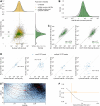Nuclear export is a limiting factor in eukaryotic mRNA metabolism
- PMID: 38753883
- PMCID: PMC11135743
- DOI: 10.1371/journal.pcbi.1012059
Nuclear export is a limiting factor in eukaryotic mRNA metabolism
Abstract
The eukaryotic mRNA life cycle includes transcription, nuclear mRNA export and degradation. To quantify all these processes simultaneously, we perform thiol-linked alkylation after metabolic labeling of RNA with 4-thiouridine (4sU), followed by sequencing of RNA (SLAM-seq) in the nuclear and cytosolic compartments of human cancer cells. We develop a model that reliably quantifies mRNA-specific synthesis, nuclear export, and nuclear and cytosolic degradation rates on a genome-wide scale. We find that nuclear degradation of polyadenylated mRNA is negligible and nuclear mRNA export is slow, while cytosolic mRNA degradation is comparatively fast. Consequently, an mRNA molecule generally spends most of its life in the nucleus. We also observe large differences in the nuclear export rates of different 3'UTR transcript isoforms. Furthermore, we identify genes whose expression is abruptly induced upon metabolic labeling. These transcripts are exported substantially faster than average mRNAs, suggesting the existence of alternative export pathways. Our results highlight nuclear mRNA export as a limiting factor in mRNA metabolism and gene regulation.
Copyright: © 2024 Müller et al. This is an open access article distributed under the terms of the Creative Commons Attribution License, which permits unrestricted use, distribution, and reproduction in any medium, provided the original author and source are credited.
Conflict of interest statement
The authors have declared that no competing interests exist.
Figures




Similar articles
-
PKC Regulates YAP Expression through Alternative Splicing of YAP 3'UTR Pre-mRNA by hnRNP F.Int J Mol Sci. 2021 Jan 12;22(2):694. doi: 10.3390/ijms22020694. Int J Mol Sci. 2021. PMID: 33445676 Free PMC article.
-
CRM1-dependent, but not ARE-mediated, nuclear export of IFN-alpha1 mRNA.J Cell Sci. 2004 May 1;117(Pt 11):2259-70. doi: 10.1242/jcs.01076. J Cell Sci. 2004. PMID: 15126627
-
Heat shock and ethanol stress provoke distinctly different responses in 3'-processing and nuclear export of HSP mRNA in Saccharomyces cerevisiae.Biochem J. 2008 Aug 15;414(1):111-9. doi: 10.1042/BJ20071567. Biochem J. 2008. PMID: 18442359
-
Nuclear mRNA export.Acta Biochim Biophys Sin (Shanghai). 2024 Sep 3;57(1):84-100. doi: 10.3724/abbs.2024145. Acta Biochim Biophys Sin (Shanghai). 2024. PMID: 39243141 Free PMC article. Review.
-
Implications of polyadenylation in health and disease.Nucleus. 2014;5(6):508-19. doi: 10.4161/nucl.36360. Epub 2014 Oct 31. Nucleus. 2014. PMID: 25484187 Free PMC article. Review.
Cited by
-
Halfpipe: a tool for analyzing metabolic labeling RNA-seq data to quantify RNA half-lives.NAR Genom Bioinform. 2025 Feb 18;7(1):lqaf006. doi: 10.1093/nargab/lqaf006. eCollection 2025 Mar. NAR Genom Bioinform. 2025. PMID: 39967604 Free PMC article.
-
Coupling mechanisms coordinating mRNA translation with stages of the mRNA lifecycle.RNA Biol. 2025 Dec;22(1):1-12. doi: 10.1080/15476286.2025.2483001. Epub 2025 Mar 24. RNA Biol. 2025. PMID: 40116043 Free PMC article. Review.
-
Quantifying 3'UTR length from scRNA-seq data reveals changes independent of gene expression.Nat Commun. 2024 May 14;15(1):4050. doi: 10.1038/s41467-024-48254-9. Nat Commun. 2024. PMID: 38744866 Free PMC article.
-
Pituitary adenylate cyclase-activating polypeptide (PACAP)+ cells in the paraventricular nucleus of the thalamus: relationship with binge-type eating in male and female mice.Psychopharmacology (Berl). 2025 Feb;242(2):413-426. doi: 10.1007/s00213-024-06692-9. Epub 2024 Sep 28. Psychopharmacology (Berl). 2025. PMID: 39340653 Free PMC article.
-
Subcellular mRNA kinetic modeling reveals nuclear retention as rate-limiting.Mol Syst Biol. 2024 Dec;20(12):1346-1371. doi: 10.1038/s44320-024-00073-2. Epub 2024 Nov 15. Mol Syst Biol. 2024. PMID: 39548324 Free PMC article.
References
-
- Boehringer A, Bowser R. RNA Nucleocytoplasmic Transport Defects in Neurodegenerative Diseases. In: Sattler R, Donnelly CJ, editors. RNA Metabolism in Neurodegenerative Diseases. Advances in Neurobiology. Cham: Springer International Publishing; 2018. p. 85–101. Available from: 10.1007/978-3-319-89689-2_4 - DOI - PubMed
MeSH terms
Substances
LinkOut - more resources
Full Text Sources
Molecular Biology Databases

